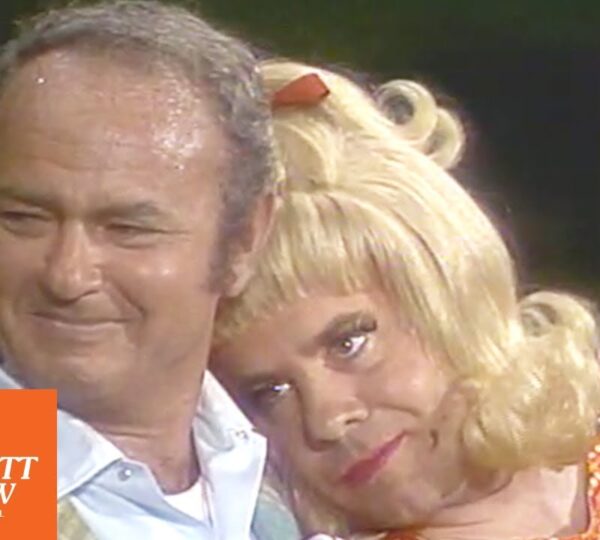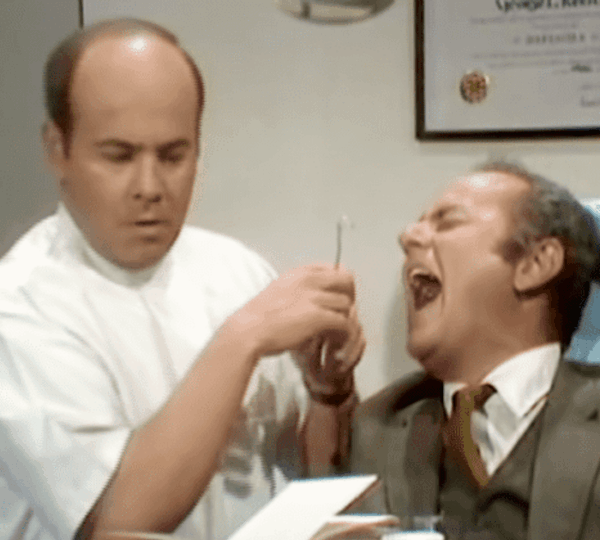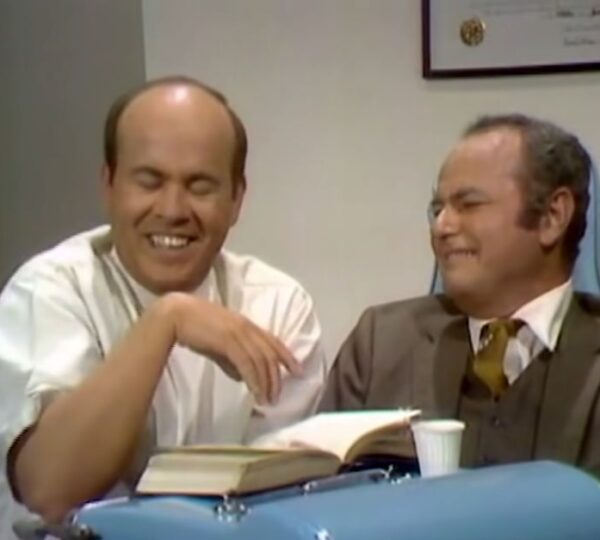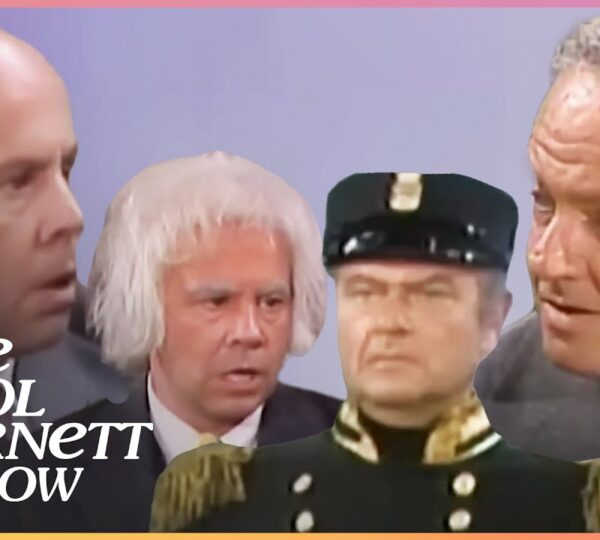Television history is filled with memorable moments, but only a handful attain the rare status of becoming eternal — scenes so perfectly timed, so beautifully acted, and so universally joyful that they transcend their own era.
One such masterpiece comes from The Carol Burnett Show, where Tim Conway and Harvey Korman delivered a performance that continues to resonate across generations. Their now-legendary sketch, “The Old Sheriff,” stands as a testament to the art of comedic storytelling and the power of genuine laughter shared between performers and their audience.
This extended exploration takes you deeper into the heart of that unforgettable moment: its origins, its structure, the artistry behind the performances, the atmosphere in the studio that night, the history of Conway and Korman’s partnership, and the lasting legacy the sketch left on American entertainment.
A Return to an Era of Heartfelt Comedy
Long before streaming platforms and digital entertainment dominated the cultural landscape, television relied on a different kind of magic — a magic powered by instinct, chemistry, careful timing, and the presence of real audiences who shaped every beat of a performer’s choices.
The Carol Burnett Show, premiering in 1967, became a beloved sanctuary for viewers who wanted to laugh, unwind, and feel connected. It was built on warmth, intelligence, and a cast that understood how to blend structure with spontaneity.
Among its brightest stars were Tim Conway and Harvey Korman, two comedians whose partnership became legendary not because of rehearsed precision, but because of their ability to bring authenticity into every joke.
Conway’s unpredictable creativity paired with Korman’s expressive reactions made every sketch feel like an event — a moment that couldn’t be repeated exactly the same way twice.
“The Old Sheriff” emerged from this creative environment, representing everything that made the show extraordinary.

The Scene Opens: Entering a Western World Like No Other
The sketch begins with cinematic flair: a dusty saloon, wooden doors that swing lazily, and a piano playing softly in the background.
The lighting is warm and slightly dim, evoking the classic Western saloons audiences had seen in movies for decades. The set crew built this world with care, but it was the performers who breathed life into it.
The moment Tim Conway enters, the atmosphere shifts. His sheriff is not the bold, fearless lawman audiences expected. Instead, he moves with deliberate slowness — a pace so exaggerated that the studio audience immediately senses the joke.
His posture sinks slightly with the weight of each step. His boots barely lift from the floor. His eyelids descend like curtains at the end of a play. Even the tilt of his hat seems to take a full second longer than physics should allow.
Yet Conway plays it with absolute seriousness. He does not wink at the audience. He does not smile. He commits to the character fully, allowing the humor to arise naturally from the tension he creates.

Harvey Korman Takes the Stage: A Master of Reaction
Opposite Conway stands Harvey Korman, dressed as a nervous outlaw caught in the sheriff’s slow-motion orbit. Korman’s character expects confrontation — perhaps a duel, a stern lecture, or a daring arrest.
Instead, he faces something far more baffling: a sheriff so slow that the outlaw begins to question whether the laws of time still apply inside that saloon.
This contrast sets the stage for one of the greatest comedic duels of all time:
-
Conway’s calm control
-
Korman’s unraveling patience
-
Conway’s stillness
-
Korman’s escalating panic
-
Conway’s silence
-
Korman’s barely contained laughter
The result is a comedy rhythm that builds steadily, like an orchestra rising toward its crescendo.

The Art of Slowness: Conway’s Genius in Motion
Tim Conway had a rare gift — the ability to take something simple and elevate it to profound comedic brilliance. In this sketch, that “something” was slowness. But it wasn’t just slowness for the sake of being slow. It was deliberate, layered, purposeful.
His movements were crafted with precision:
-
A step that took nearly a full second to complete
-
A blink that lingered long enough to make the audience lean forward
-
A head turn that became its own visual punchline
-
A hand gesture that stretched time like taffy
The genius behind this performance lies in Conway’s understanding of human expectation. He knew the audience would anticipate speed. He knew they expected a sheriff to be sharp, alert, confident. And so he gave them the opposite — an almost meditative tranquility that defied the genre and produced laughter simply by existing.

Korman’s Struggle Becomes a Second Comedy Show
What truly elevated the sketch into legendary territory was Harvey Korman’s reaction. Korman was supposed to play it straight — the anxious outlaw trapped in a slow nightmare. But as Conway stretched every movement, Korman found himself battling a different enemy: uncontrollable laughter.
This internal struggle became visible to everyone:
-
His lips tightened
-
His shoulders trembled
-
His eyes watered
-
His breathing quickened
-
His attempts to speak faltered
-
His body swayed, overcome by the urge to laugh
The camera caught everything, and the studio audience roared with appreciation. They weren’t just watching a performance — they were witnessing a genuine, unscripted human reaction. That vulnerability made the moment organic, relatable, and deeply funny.

A Scene That Builds Like a Symphony
The sketch unfolded with a musical elegance, each beat building on the last. Conway slowed his movements even more, fueling the laughter. Korman’s reactions grew increasingly dramatic, transforming the scene into a dance of contrast between serenity and chaos.
The pacing was intentionally experimental:
-
Conway’s stillness became louder than words
-
Korman’s attempts to regain composure became jokes in themselves
-
Silent pauses turned into comedic drumbeats
-
Every delayed action became an unexpected surprise
Audiences in the studio and at home could not look away. The tension — the joy — the anticipation — all merged into a comedic experience so rich that it left viewers laughing long after the sketch ended.
Behind the Scenes: How Conway Loved Making Korman Laugh
It was well known among the cast and crew that Conway loved making Korman break character. He often improvised details during live performances just to challenge Korman’s composure. “The Old Sheriff” was one of Conway’s favorite opportunities to push these boundaries.
During rehearsals, Conway performed the character slowly — but not THIS slowly. The extreme slowness seen in the final sketch was something Conway saved for the live audience.
This surprise threw Korman completely off balance, explaining why his laughter was so pure, so immediate, and so impossible to control.
Their director later recalled:
“You could hear the entire crew laughing behind the cameras. Everyone knew we were witnessing something truly special.”
Why This Sketch Remains a Cultural Treasure
More than 40 years later, “The Old Sheriff” continues to attract millions of viewers online. Why does it remain so powerful?
1. The Humor Is Universal
There is no language barrier in slow-motion comedy. Anyone can appreciate the contrast between two personalities — one frantic, one serene.
2. The Laughter Is Genuine
Audiences sense authenticity instantly. Watching Korman struggle makes the experience contagious.
3. It Represents an Era of Warmth
Television today often relies on fast cuts, digital effects, or exaggerated shock humor. Conway and Korman show how simplicity can create deeper, more lasting joy.
4. It Highlights the Magic of Human Connection
The sketch succeeds because two performers genuinely enjoyed working together.
5. It Honors the Craft of Physical Comedy
Conway’s performance demonstrates how movement, silence, and timing can be more powerful than dialogue.
A Legacy That Continues to Inspire Generations
Tim Conway and Harvey Korman passed away years apart, but their work remains alive in the hearts of comedy lovers everywhere.
Modern comedians study their interactions. Actors mimic Conway’s timing. Television historians cite this sketch as one of the clearest examples of how chemistry can elevate simple writing into artistic brilliance.
Even younger audiences — those discovering classic television for the first time — find themselves drawn to the authenticity of these moments.
They write comments describing how they laughed until they cried, how they shared the clip with friends or family members, how the sketch offered comfort during difficult days.
“The Old Sheriff” is no longer just a comedy sketch — it is a shared cultural memory, a warm reminder of an era when entertainment brought families together around the television, when laughter was pure, and when performers poured their hearts into their craft.
Conclusion: A Comedy Masterpiece That Transcends Time
Tim Conway and Harvey Korman’s “The Old Sheriff” remains one of the most brilliant examples of comedic timing, performance artistry, and human connection ever captured on film. Through silence, slowness, reactions, and genuine laughter, they created a moment that continues to inspire joy decades later.
Their performance stands as a tribute to:
-
the beauty of laughter
-
the importance of timing
-
the charm of spontaneity
-
the power of simple humor
-
and the enduring magic of classic television
Even today, as viewers rediscover this masterpiece, the sketch feels just as fresh and delightful as it did during its original broadcast. It proves that great comedy is timeless — and that the joy of shared laughter lives on forever.
Television history is filled with memorable moments, but only a handful attain the rare status of becoming eternal — scenes so perfectly timed, so beautifully acted, and so universally joyful that they transcend their own era.
One such masterpiece comes from The Carol Burnett Show, where Tim Conway and Harvey Korman delivered a performance that continues to resonate across generations. Their now-legendary sketch, “The Old Sheriff,” stands as a testament to the art of comedic storytelling and the power of genuine laughter shared between performers and their audience.
This extended exploration takes you deeper into the heart of that unforgettable moment: its origins, its structure, the artistry behind the performances, the atmosphere in the studio that night, the history of Conway and Korman’s partnership, and the lasting legacy the sketch left on American entertainment.
A Return to an Era of Heartfelt Comedy
Long before streaming platforms and digital entertainment dominated the cultural landscape, television relied on a different kind of magic — a magic powered by instinct, chemistry, careful timing, and the presence of real audiences who shaped every beat of a performer’s choices.
The Carol Burnett Show, premiering in 1967, became a beloved sanctuary for viewers who wanted to laugh, unwind, and feel connected. It was built on warmth, intelligence, and a cast that understood how to blend structure with spontaneity.
Among its brightest stars were Tim Conway and Harvey Korman, two comedians whose partnership became legendary not because of rehearsed precision, but because of their ability to bring authenticity into every joke.
Conway’s unpredictable creativity paired with Korman’s expressive reactions made every sketch feel like an event — a moment that couldn’t be repeated exactly the same way twice.
“The Old Sheriff” emerged from this creative environment, representing everything that made the show extraordinary.

The Scene Opens: Entering a Western World Like No Other
The sketch begins with cinematic flair: a dusty saloon, wooden doors that swing lazily, and a piano playing softly in the background.
The lighting is warm and slightly dim, evoking the classic Western saloons audiences had seen in movies for decades. The set crew built this world with care, but it was the performers who breathed life into it.
The moment Tim Conway enters, the atmosphere shifts. His sheriff is not the bold, fearless lawman audiences expected. Instead, he moves with deliberate slowness — a pace so exaggerated that the studio audience immediately senses the joke.
His posture sinks slightly with the weight of each step. His boots barely lift from the floor. His eyelids descend like curtains at the end of a play. Even the tilt of his hat seems to take a full second longer than physics should allow.
Yet Conway plays it with absolute seriousness. He does not wink at the audience. He does not smile. He commits to the character fully, allowing the humor to arise naturally from the tension he creates.

Harvey Korman Takes the Stage: A Master of Reaction
Opposite Conway stands Harvey Korman, dressed as a nervous outlaw caught in the sheriff’s slow-motion orbit. Korman’s character expects confrontation — perhaps a duel, a stern lecture, or a daring arrest.
Instead, he faces something far more baffling: a sheriff so slow that the outlaw begins to question whether the laws of time still apply inside that saloon.
This contrast sets the stage for one of the greatest comedic duels of all time:
-
Conway’s calm control
-
Korman’s unraveling patience
-
Conway’s stillness
-
Korman’s escalating panic
-
Conway’s silence
-
Korman’s barely contained laughter
The result is a comedy rhythm that builds steadily, like an orchestra rising toward its crescendo.

The Art of Slowness: Conway’s Genius in Motion
Tim Conway had a rare gift — the ability to take something simple and elevate it to profound comedic brilliance. In this sketch, that “something” was slowness. But it wasn’t just slowness for the sake of being slow. It was deliberate, layered, purposeful.
His movements were crafted with precision:
-
A step that took nearly a full second to complete
-
A blink that lingered long enough to make the audience lean forward
-
A head turn that became its own visual punchline
-
A hand gesture that stretched time like taffy
The genius behind this performance lies in Conway’s understanding of human expectation. He knew the audience would anticipate speed. He knew they expected a sheriff to be sharp, alert, confident. And so he gave them the opposite — an almost meditative tranquility that defied the genre and produced laughter simply by existing.

Korman’s Struggle Becomes a Second Comedy Show
What truly elevated the sketch into legendary territory was Harvey Korman’s reaction. Korman was supposed to play it straight — the anxious outlaw trapped in a slow nightmare. But as Conway stretched every movement, Korman found himself battling a different enemy: uncontrollable laughter.
This internal struggle became visible to everyone:
-
His lips tightened
-
His shoulders trembled
-
His eyes watered
-
His breathing quickened
-
His attempts to speak faltered
-
His body swayed, overcome by the urge to laugh
The camera caught everything, and the studio audience roared with appreciation. They weren’t just watching a performance — they were witnessing a genuine, unscripted human reaction. That vulnerability made the moment organic, relatable, and deeply funny.

A Scene That Builds Like a Symphony
The sketch unfolded with a musical elegance, each beat building on the last. Conway slowed his movements even more, fueling the laughter. Korman’s reactions grew increasingly dramatic, transforming the scene into a dance of contrast between serenity and chaos.
The pacing was intentionally experimental:
-
Conway’s stillness became louder than words
-
Korman’s attempts to regain composure became jokes in themselves
-
Silent pauses turned into comedic drumbeats
-
Every delayed action became an unexpected surprise
Audiences in the studio and at home could not look away. The tension — the joy — the anticipation — all merged into a comedic experience so rich that it left viewers laughing long after the sketch ended.
Behind the Scenes: How Conway Loved Making Korman Laugh
It was well known among the cast and crew that Conway loved making Korman break character. He often improvised details during live performances just to challenge Korman’s composure. “The Old Sheriff” was one of Conway’s favorite opportunities to push these boundaries.
During rehearsals, Conway performed the character slowly — but not THIS slowly. The extreme slowness seen in the final sketch was something Conway saved for the live audience.
This surprise threw Korman completely off balance, explaining why his laughter was so pure, so immediate, and so impossible to control.
Their director later recalled:
“You could hear the entire crew laughing behind the cameras. Everyone knew we were witnessing something truly special.”
Why This Sketch Remains a Cultural Treasure
More than 40 years later, “The Old Sheriff” continues to attract millions of viewers online. Why does it remain so powerful?
1. The Humor Is Universal
There is no language barrier in slow-motion comedy. Anyone can appreciate the contrast between two personalities — one frantic, one serene.
2. The Laughter Is Genuine
Audiences sense authenticity instantly. Watching Korman struggle makes the experience contagious.
3. It Represents an Era of Warmth
Television today often relies on fast cuts, digital effects, or exaggerated shock humor. Conway and Korman show how simplicity can create deeper, more lasting joy.
4. It Highlights the Magic of Human Connection
The sketch succeeds because two performers genuinely enjoyed working together.
5. It Honors the Craft of Physical Comedy
Conway’s performance demonstrates how movement, silence, and timing can be more powerful than dialogue.
A Legacy That Continues to Inspire Generations
Tim Conway and Harvey Korman passed away years apart, but their work remains alive in the hearts of comedy lovers everywhere.
Modern comedians study their interactions. Actors mimic Conway’s timing. Television historians cite this sketch as one of the clearest examples of how chemistry can elevate simple writing into artistic brilliance.
Even younger audiences — those discovering classic television for the first time — find themselves drawn to the authenticity of these moments.
They write comments describing how they laughed until they cried, how they shared the clip with friends or family members, how the sketch offered comfort during difficult days.
“The Old Sheriff” is no longer just a comedy sketch — it is a shared cultural memory, a warm reminder of an era when entertainment brought families together around the television, when laughter was pure, and when performers poured their hearts into their craft.
Conclusion: A Comedy Masterpiece That Transcends Time
Tim Conway and Harvey Korman’s “The Old Sheriff” remains one of the most brilliant examples of comedic timing, performance artistry, and human connection ever captured on film. Through silence, slowness, reactions, and genuine laughter, they created a moment that continues to inspire joy decades later.
Their performance stands as a tribute to:
-
the beauty of laughter
-
the importance of timing
-
the charm of spontaneity
-
the power of simple humor
-
and the enduring magic of classic television
Even today, as viewers rediscover this masterpiece, the sketch feels just as fresh and delightful as it did during its original broadcast. It proves that great comedy is timeless — and that the joy of shared laughter lives on forever.






